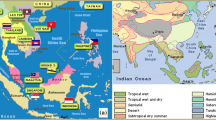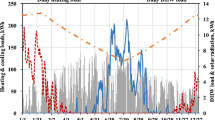Abstract
Positive energy residential buildings are houses that generate more energy from renewable sources than they consume while maintaining appropriate thermal comfort levels. However, their design, construction and operation present several critical challenges. In particular, the considerable load reductions are not always compatible with the increased level of comfort expected in modern houses. Tropical climates, meanwhile, should be more amenable to the implementation of positive energy houses for two reasons. Firstly, negligible heating is generally required as compared to colder climates, where the heating energy requirements are considerable. Then, renewable energy resources are usually abundant in tropical climates. This paper investigates the feasibility of positive energy residential buildings in the tropical island of Mauritius. A baseline model representing a typical Mauritian house is designed using DesignBuilder software. The energy efficiency of the model is then optimised by investigating a whole range of passive building design strategies, many of them adapted from vernacular architecture. Results reveal that the application of passive strategies such as shading, insulation and natural ventilation have precluded the need for artificial cooling and ventilation in the positive energy (PE) house. The resulting electricity consumption of the house decreases from 24.14 to 14.30 kWh/m2/year. A 1.2 kW photovoltaic system provides the most cost-effective solution to exceed the annual electricity requirements of the house.













Similar content being viewed by others
References
AlekoGreenEnergy. (2015). WG1500 Wind turbine generator 1500W 48V complete power system. http://www.alekogreenenergy.com/product-p/wg1500w48vci.html. Accessed 14 March 2015.
ASHRAE. (2013). ANSI/ASHRAE Standard 55–2013. Atlanta: Thermal Environmental Conditions for Human Occupancy.
Barclay, M., Kang, J., & Sharples, S. (2012). Combining noise mapping and ventilation performance for non-domestic buildings in an urban area. Building and Environment, 52, 68–76.
Bojić, M., Nikolić, N., Nikolić, D., Skerlić, J., & Miletić, I. (2011). Toward a positive-net-energy residential building in Serbian conditions. Applied Energy, 88(7), 2407–2419.
Bromberek, Z. (2009). Eco-resorts: planning and design for the tropics. Elsevier Architectural.
Carassus, J. (2010). Comment décrypter les différents labels de performance energetique? Paris: Efficacite energetique des batiments.
CEB (Central Electricity Board). (2010). Feed-in tariff. http://ceb.intnet.mu/grid_code/feedin.asp. Accessed 18 February 2015.
CEB (Central Electricity Board). (2012). Annual report 2011. Republic of Mauritius. http://ceb.intnet.mu/CorporateInfo/ar2011.pdf. Accessed 25 February 2015.
CEB (Central Electricity Board). (2013). Integrated electricity plan 2013–2022: Chapter 4: demand forecast for Mauritius. http://ceb.intnet.mu/CorporateInfo/IEP2013/Chapter4_Demand%20Forecast%20for%20Mauritius.pdf. Accessed 25 February 2015.
CEB (Central Electricity Board). (2015). Proposed applicable tariff for Prosumers. http://ceb.intnet.mu/ssdg/document/Tariff.pdf. Accessed 01 March 2016.
CSO (Central Statistics Office). (2011a). http://statsmauritius.govmu.org/English/CensusandSurveys/Pages/census/Census-2011.aspx. Accessed 23 February 2015.
CSO (Central Statistics Office). (2011b). Population census of Mauritius. Republic of Mauritius.
CSO (Central Statistics Office). (2013). Household budget survey 2012: preliminary results. Republic of Mauritius.
CSO (Central Statistics Office). (2014a). Digest of energy and water statistics—2013. Republic of Mauritius. http://statsmauritius.govmu.org/English/Publications/Documents/Regular%20Reports/energy%20and%20water/Energy2013.pdf. Accessed 23 February 2015.
CSO (Central Statistics Office). (2014b). Mauritius in figures 2013. Republic of Mauritius. http://statsmauritius.govmu.org/English/Publications/Pages/Mauritius-in-Figures.aspx. Accessed 23 February 2015.
CIBSE. (2006). CIBSE guide A: environmental design. Chartered Institution of Building Services Engineers.
Crawley, D., Pless, S., & Torcellini, P. (2009). Getting to net zero. ASHRAE Journal, 51(9), 18–25.
Dincer, I., Midilli, A., & Kucuk, H. (2014). Progress in exergy, energy, and the environment. New York: Springer International.
AFREPREN/FWD. (2009). The role of feed-in tariff policy in renewable energy development in developing countries. Nairobi: Energy, Environment and Development Network for Africa.
European Union. (2014). Market study for a voluntary common European Union certification scheme for the energy performance of non-residential buildings. ENER/C3/2012-436.
Franco, M., Baird, G., Garde, F., & Lenoir, A. (2011). Environmental design and performance of the ENERPOS building, Reunion island, France. Sydney: ANZASCA Conference.
Frischknecht, R., Wyss, F., Knöpfel, S. B., & Stolz, P. (2015). Life cycle assessment in the building sector: analytical tools, environmental information and labels. The International Journal of Life Cycle Assessment, 20(4), 421–425.
Futloo, A. (2009). Life-cycle assessment of a typical Mauritian house with focus on main building materials and components. University of Mauritius
Garde, F., & Donn, M. (2014). Solution sets and net zero energy buildings : a review of 30 Net ZEBs case studies worldwide. International Energy Agency, http://task40.iea-shc.org/data/sites/1/publications/T40A52-DC-TR1-30-Net-ZEBs.pdf. Accessed 14 December 2014.
Hassoun, A., & Dincer, I. (2014). Design and assessment of a net zero energy house. Progress in Exergy, Energy, and the Environment, 399–414
Kibert, C. J. (2008). Sustainable construction: green building design and delivery. New Jersey: John Wiley & Sons.
Kolokotsaa, D., Rovas, D., Kosmatopoulos, E., & Kalaitzakis, K. (2011). A roadmap towards intelligent net zero- and positive-energy buildings. Solar Energy, 85(12), 3067–3084.
Kurnitski, J., Buso, T., Corgnati, S. P., Derjanecz, A., & Litiu, A. (2014). NZEB definitions in Europe. REHVA Journal, 6–9
Lenoir, A. (2013). On comfort in tropical climates—the design and operation of net zero energy buildings. Universite de La Reunion
Lenoir, A., & Garde, F. (2012). Tropical NZEB. High performing buildings, 42–57
Levinson, R., & Akbari, H. (2010). Potential benefits of cool roofs on commercial buildings: conserving energy, saving money, and reducing emission of greenhouse gases and air pollutants. Energy Efficiency, 3, 53–109.
Maggino, F., & Ruviglioni, E. (2011). Obtaining weights: from objective to subjective approaches in view of more participative methods in the construction of composite indicators. Brussels: Eurostat - New techniques and technologies for statistics.
MMS (Mauritius Meteorological Services). (2014). Climate of Mauritius. http://metservice.intnet.mu/climate-services/climate-of-mauritius.php. Accessed 16 December 2014.
McKeen, P., & Fung, A. S. (2014). The effect of building aspect ratio on energy efficiency: a case study for multi-unit residential buildings in Canada. Buildings, 4, 336–354.
Miller, W., & Buys, L. (2012). Anatomy of a sub-tropical positive energy home (PEH). Solar Energy, 86(1), 231–241.
MFED (Ministry of Finance and Economic Development). (2004). Removal of barriers to energy efficiency and energy conservation in buildings. Republic of Mauritius.
MPU (Ministry of Public Utilities). (2006). "Economiser L’Energie: Je le peux dès aujourd’hui". Republic of Mauritius. (in French).
MREPU (Ministry of Renewable Energy & Public Utilities. (2009). Long-term energy strategy 2009–2025. Republic of Mauritius.
NREL (National Renewable Energy Laboratory). (1996). EnergyPlus documentation—the reference to EnergyPlus calculations. U. S. Department of Energy.
NREL (National Renewable Energy Laboratory). (2015). The next generation of renewable energy policy: how rapid change is breaking down conventional policy categories. NREL/TP-7A40-63149.
Panagiotidou, M., & Fuller, R. J. (2013). Progress in ZEBs—a review of definitions, policies and construction activity. Energy Policy, 62, 196–206.
Peng, C., Huanga, L., Liud, J., & Huang, Y. (2015). Energy performance evaluation of a marketable net-zero-energy house: Solark I at Solar Decathlon China 2013. Renewable Energy, 81, 136–149.
Rahman, M. M., Rasul, M. G., & Khan, M. K. (2010). Energy conservation measures in an institutional building in sub-tropical climate in Australia. Applied Energy, 87(10), 2994–3004.
Rouach, L. (2013). A comparison of green building certifications in Europe: how does it apply to practice in Luxembourg. LuxReal FORUM Sustainability.
Shanthi Priya, R., Sundarraja, M. C., & Radhakrishnan, S. (2012). Experimental study on the thermal performance of a traditional house with one-sided wind catcher during summer and winter. Energy Efficiency, 5, 483–496.
Siraki, A. G., & Pillay, P. (2012). Study of optimum tilt angles for solar panels in different latitudes for urban applications. Solar Energy, 86(6), 1920–1928.
Vassig, S., Ozer, E., & Spiegelhalter, T. (2012). Best practices in sustainable building design. J Ross Press Series.
Voss, K., & Musall, E. (2012). Net zero energy buildings: international projects of carbon neutrality in buildings (2nd ed.). International Energy Agency.
Wang, L., Gwilliam, J., & Jones, P. (2009). Case study of zero energy house design in UK. Energy and Buildings, 41, 1215–1222.
Wholesalesolar.com. (2015). Astronergy CHSM 6612P 300-watt solar panels. http://www.wholesalesolar.com/products.folder/module-folder/Astronergy/CHSM6612P-300.html. Accessed 13 March 2015.
Yang, T., & Clements-Croome, D. J. (2013). Natural ventilation in built environment. Sustainable Built Environments, 394–425
Zanchini, E., & Lazzari, S. (2014). Design of a nearly zero energy one-family house in north-centre Italy. Progress in Sustainable Energy Technologies Vol II., 165–186
Zhai, Z., & Previtali, J. M. (2010). Ancient vernacular architecture: characteristics, categorization and energy performance evaluation. Energy and Buildings, 42, 357–365.
Author information
Authors and Affiliations
Corresponding author
Rights and permissions
About this article
Cite this article
Oree, V., Anatah, H.K. Investigating the feasibility of positive energy residential buildings in tropical climates. Energy Efficiency 10, 383–404 (2017). https://doi.org/10.1007/s12053-016-9462-7
Received:
Accepted:
Published:
Issue Date:
DOI: https://doi.org/10.1007/s12053-016-9462-7




